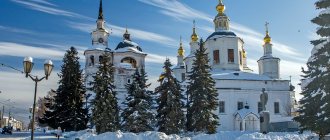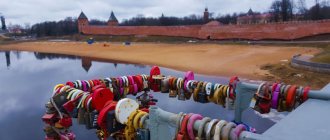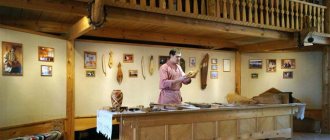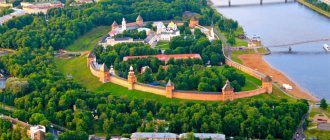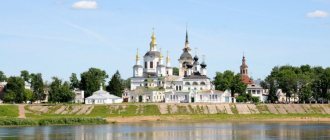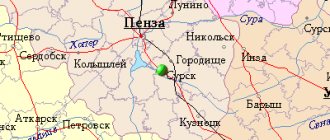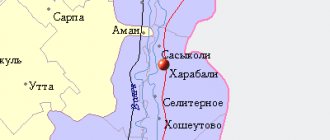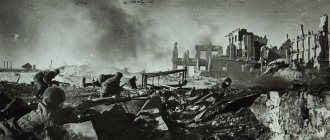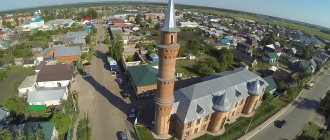Founded: 1147
The date of the city day is unique for each year.
In 2021,
this date is
July 24
.
In 2021, due to the pandemic, mass events in honor of the city day are canceled or may be postponed
Veliky Ustyug - the soul of the Russian North
Veliky Ustyug
- a Russian city located in the Vologda region, on the left bank of the Sukhona River at the confluence of the Yug River.
First
the settlement was mentioned under the name Gleden in 1147. In 1212, the Mikhailo-Arkhangelsky Monastery was built at the mouth of the Yug River, which is why the place is called Ustyug.
In 1218, Ustyug was ravaged by the Kama Bulgarians. In the 14th century, a struggle took place between the Novgorod and Moscow principalities for possession of the city, which controlled the waterway along the northern rivers. In 1398, the Assumption Cathedral was plundered and burned by the Novgorodians, and the icon of the Miraculous Hodegetria was taken prisoner.
In 1399, Bishop John of Novgorod ordered the miraculous icon to be returned and the Ustyug Cathedral to be rebuilt. At the end of the 14th century, Ustyug finally became part of the Moscow Principality and became the center of the annexation of the northern lands.
In 1465, the Ustyuans conquered the Ugra land, in 1472 they helped annex the Perm land, and in 1489, the Vyatichi land. In the mid-16th century, Ustyug ceased to be a border fortification and lost its military significance.
In 1553, a trade route to the West was opened - from Vologda through the Sukhona and Northern Dvina to the White Sea. Ustyug occupied an important position on this path. In 1565, Ivan the Terrible included Ustyug among the oprichnina cities that provided money for the sovereign's household needs. During this period, the epithet Great was added to the name of the city.
In the 18th century, the Northern trade route lost its importance. Urban trade is declining, and handicraft industries and crafts are developing in the city. In 1918 – 1929 Veliky Ustyug was the center of the North Dvina province of the RSFSR. Nowadays the city is widely known as a tourist center.
There are 28 churches in the city (17-18th century): the Assumption Cathedral, the Cathedral of Procopius the Righteous, the Cathedral of John of Ustyug, the Church of Sergius of Radonezh and others. Several dozen monuments of urban architecture of the 19th century.
Tower of Father Frost
It is interesting
that in 1999 Veliky Ustyug was declared the birthplace of the Russian Father Frost. In addition to Father Frost, the city is famous for other famous travelers: Semyon Dezhnev, who discovered the strait between Asia and America. Erofei Khabarov, who paved the way to the banks of the Amur and compiled its first map. Vasily Shilov and Mikhail Navodchikov are the discoverers of the Aleutian Islands. Vladimir Atlasov, who explored Kamchatka.
The city has a population of about 31 thousand people (2020).
Day of the city
was celebrated in mid-June and was famous for the fact that only in Veliky Ustyug on City Day did Father Frost congratulate the townspeople. However, recently the local administration decided to combine City Day and the Prokopyevskaya Fair, which is dedicated to the day of memory of Procopius the Righteous, the heavenly patron of Ustyug, whose memory is celebrated on July 21.
Veliky Ustyug
Video: Veliky Ustyug
Historical reference
Veliky Ustyug - the birthplace of Father Frost
Veliky Ustyug is a settlement in Russia, located in the Vologda region. Initially it was called simply Ustyug. In the 16th century, the city was noted by Ivan the Terrible for its significant contribution to the state treasury, thanks to its strategic location for trade, and received the prefix “Great”. Since the first settlement arose here back in the 13th century with the assistance of the Rostov-Suzdal princes, it is impossible to establish for certain the origin of the name. However, the most logical version is that the name familiar to the ear is the result of combining the phrase “mouth of the South” - the place where two branches merge into the Northern Dvina.
For quite a long time, one of the main outposts was located here, designed to restrain the aggressive appetites of the Bulgar tribes and Novgorodians, therefore, until it became part of the Moscow principality under Vasily I, Veliky Ustyug was repeatedly subjected to sieges and destruction, but was rebuilt.
It experienced its “golden age” in the 17th century, when the waterway along the Northern Dvina became the main method of transportation for merchants who were engaged in foreign trade. But the administrative reform of Peter I made Ustyug a province, since the new access to the Baltic Sea completely redrew the scheme of transport and economic communications, and the former importance of many northern cities was lost. To top it all off, due to too dense buildings, at the end of the 18th century there was a big fire that destroyed almost the entire settlement. Thanks to a successful reconstruction plan, it was possible to preserve the old buildings as much as possible, which is why the historical center of Veliky Ustyug is so valuable in architectural terms.
Streets of Veliky UstyugThe next major shock for the ancient city was the barbaric destruction of religious buildings in the 30s of the last century. Veliky Ustyug lost many churches, chapels and even cathedrals, and some of the premises that belonged to the monasteries are still in the possession of local technical schools.
Architectural monuments
Since we are talking about history, it is impossible not to talk about the buildings that were witnesses of past eras. Today Veliky Ustyug is an excellent example of how reverently one should treat the heritage of ancestors - its entire center has been declared the territory of a museum-reserve. This decision of the local authorities made it possible to impose a ban not only on construction in old neighborhoods, but also on changing the facades of existing houses, and therefore helped to preserve the authentic appearance of Veliky Ustyug, so attractive to tourists and researchers.
The Assumption Cathedral dates back to 1639-1658, but in the same place previously stood the wooden Church of the Dormition of the Mother of God of the 13th century, built during the life of the blessed wonderworker Procopius. Naturally, over time, the original project has undergone significant changes; now it demonstrates to the attentive eye a mixture of many styles. Those interested can not only inspect the interior, but also climb the bell tower, which offers a beautiful view of the surrounding area.
Assumption Cathedral of Veliky Ustyug
The cathedral courtyard, where the shrine is located, has been the real focus of the spiritual and secular life of Veliky Ustyug since ancient times. Nearby you can see 17th-century churches in honor of St. Procopius, who is considered the patron saint of the city, and John of Ustyug, as well as the Bishop's House, the building of which is a century younger.
Cathedral of Procopius of Ustyug
On the opposite bank of the Sukhona is the Dymkovo settlement with churches from the early 18th century. They bear the names of Dmitry of Thessalonica and Sergius of Radonezh. The first has preserved a unique wooden iconostasis, and the second can surprise historians only with its original tiled stoves - services were held here during the cold season. Unfortunately, both buildings are now closed to the public, but even from the outside they make a strong impression.
The construction of temples in pairs, for winter and summer, is generally a characteristic feature of Ustyug architecture. An example of this is the oldest surviving building - the Church of the Ascension of the Lord in Torg, built in 1648-1649 with the money of one of the local merchants. In style it is very different from other city churches. It is assumed that the architect was hired by a philanthropist from Moscow, where there were many masters of Russian pattern making - especially the elegant design of facades, which were distinguished by their emphasized asymmetry. In the spring of 2009, the Museum of Ancient Russian Art was opened here.
The Trinity-Gledensky Monastery, which was first mentioned in written sources in the 16th century, also performs an exclusively museum function. Some documents claim that it was founded even before the Tatar-Mongols arrived in Rus'. The modern appearance of this complex was mainly formed in the 17th century; it includes the Cathedral of the Holy Trinity, the Church of the Tikhvin Icon of the Mother of God and the Assumption of the Blessed Virgin Mary, a refectory, a hospital ward, a Watchtower and a gate.
But church historians tend to consider the Archangel Michael Monastery, founded, according to legend, in 1212, to be the most ancient in the Russian North. It is known for sure that it was abolished in 1919. Since then, a concentration camp, a museum, a military school, and a motor transport technical school have been located on the territory. However, the architectural ensemble of the monastery has been preserved surprisingly well; tourists can see the main cathedral with a bell tower, several churches (including the Prepolovenia, under which the relics of the first abbot, St. Cyprian, rest), and fraternal cells.
Also worthy of attention from guests of Veliky Ustyug are the St. Nicholas Church, Spaso-Preobrazhenskaya, St. George, Sretenskaya churches, the Temple of Simeon the Stylite, Baroque and later merchant mansions on Sovetsky Prospekt, Krasnaya Street and the embankment.
The estate of Father Frost in Veliky Ustyug
Tell me, how many places do you know where spending a few days would be equally interesting for both children and adults? Just a few minutes drive from Veliky Ustyug there is a dense pine forest, in the middle of which the residence of a good Russian wizard was built. It would not be an exaggeration to say that 1998 became a landmark year in the history of the entire region, because the start of the implementation of a large-scale project became the starting point for the new history of Veliky Ustyug. Now it has become a place of real pilgrimage for families with children and just people who dream of touching magic.
Behind a high carved fence there is a huge museum and entertainment complex. The Path of Fairy Tales leads to its main part from the very gate, where guests are cordially greeted by forest inhabitants - the winter sorcerer’s indispensable assistants. The House of Father Frost is a two-story log house, decorated with carved patterns and decorative wooden elements traditional for the Russian North. Inside there are many rooms, each of which has its own purpose: in one, for example, all existing fairy tales are waiting for their turn to be read, in another gifts are stored that will find new owners on New Year's Eve, in the third there are hundreds of interesting books about winter on the shelves. The authors of the project did not forget about the owner’s personal account, where geographic maps are stored, according to which the route of the sleigh is drawn up, a bedchamber with feather beds, and even a throne room with a beautiful Christmas tree.
Especially for those who are bothered by the question of how the ruler of snowstorms and cold escapes from the destructive summer heat, there is an opportunity to descend into the spacious Glacier. The temperature here is maintained at -15ºС all year round, which allows the amazing sculptures not to melt.
If the world of eternal cold pleasantly strikes you on a July afternoon, then being in a winter garden is probably especially joyful after the dazzling whiteness of January. In this kingdom of lush greenery and bright flowers, you want to linger as long as possible to see with your own eyes how exotic fruits grow and taste the aromatic tea that the greenhouse caretakers treat guests to.
Everyone knows that Santa Claus travels on a magic sleigh drawn by three white horses. But how do they manage to gallop all night without getting tired? Visitors to the Estate of Father Frost in Veliky Ustyug will be able not only to look at the forge where they “shoe” the fastest horses in the world, but also to forge a horseshoe for their own luck. And at the Forest Pharmacy they will be happy to share with you the secrets of miraculous northern berries and herbs.
And, of course, you can’t ignore the zoo, where you can observe the life of representatives of the local fauna, including hares, squirrels, wolves, moose, deer and a family of lynxes. Don't forget that the price of admission also includes access to three attractions of your choice. These can be ice slides, a train, riding on “cheesecakes” - soft inflatable round sleighs, sleigh rides and much more. In any case, remember the safety rules, listen to the recommendations of the employees and do not leave the kids unattended - then active entertainment will only bring a lot of positive emotions.
When you want to take a breather, go to Santa Claus's Post Office. Here is a collection of the brightest, most unusual and touching children's messages that come to the wizard's residence from all over the country. This department receives 180 thousand letters per year with the short address “Veliky Ustyug, Santa Claus.” And everyone can send postcards to family and friends with the branded fairy mail stamp.
If during a walk you meet Father Frost himself, let the children, following a good tradition, tell him their favorite poem. For such a performance, Grandfather will certainly reward the artist with a special candy from his reserves.
Museums of Veliky Ustyug
There are many truly interesting exhibitions in the city. In addition to the historical and architectural museum of Veliky Ustyug, which offers to get acquainted with the glorious past of these lands, it is recommended to visit the exhibition of New Year's cards, which presents examples of holiday messages from the beginning of the twentieth century to the present day. The museum's exhibits of New Year's and Christmas toys are devoted to a similar theme, many of which are not hidden under display glass, but hang on the branches of Christmas trees of different sizes. Grouping by historical periods allows us to visualize what forest beauties looked like in the houses of our grandmothers and great-grandmothers.
In the above-mentioned Church of the Ascension in Torg, a museum of ancient Russian art has been operating since the spring of 2009. Ancient icons, carved iconostases, collections of unique wooden sculptures and facial embroidery, and rare publications from monastery libraries that escaped looting are collected under one roof. The museum hosts master classes “In the icon-painting workshop”, where visitors are introduced to ancient painting techniques and the main stages of creating icons.
The showroom features the company’s products, which have been receiving jury recognition and prestigious awards at national and foreign exhibitions for decades. Blackening is a special type of jewelry art, and in Veliky Ustyug, working with silver is as close as possible to ancient Russian techniques, and modern design often uses ornaments known in the North since the 16th-17th centuries.
Local kitchen
Due to the climate in these latitudes, grains grow poorly in these latitudes, and there is no opportunity to engage in traditional animal husbandry, so the inhabitants of Veliky Ustyug extremely rarely ate bread and meat. But the Russian North has long been famous as a region of fishing, and the most famous dishes that are prepared here are Pomeranian fish soup, all kinds of rybniki (butter pies filled with various types of river catch), cod casserole with potatoes “Siyskaya meal”, which languishes in ovens in their own juice.
Berry and wine sauces called “volozhi” are made from lingonberries, cloudberries, currants, and rose hips, and the favorite drink of the locals is hot jelly kezh, for which they use the berries, herbs and spices on hand.
Red Street
Sovetsky Prospekt
Souvenirs and memorable gifts
You can bring so many things to your family, friends and acquaintances from Veliky Ustyug that it can make your eyes wide open. Forget about banal magnets and cups with photographs of landmarks! A practical gift would be warm socks or mittens made of sheep's wool, decorated with traditional patterns. Those with a sweet tooth will appreciate natural berry jams or cloudberries steamed in honey, an excellent addition to which will be healthy and aromatic herbal teas collected in this ecologically clean region. Local craftsmen create incredibly beautiful kitchen utensils from birch bark and hand-painted wood - such a thing will definitely remind you of you for many years. And for yourself or especially close people, buy something made of blackened silver: jewelry, cutlery, a flask for strong drinks. Exquisite patterns and ornaments will not leave anyone indifferent!
Where to stay?
Over the past decade and a half, many comfortable hotels and private mini-hotels have been built in Veliky Ustyug and its surroundings. The cost of living in them depends on the number of “stars” and the distance from the historical center. Travelers who are not afraid of a few extra minutes in a taxi or by private vehicle often prefer rural guest houses, where they can get a cozy room and a delicious home-cooked breakfast at a reasonable price. Suburban recreation centers are perfect for large companies. In addition, if you plan a trip to Veliky Ustyug in advance, there is every chance not only to visit the Estate of Father Frost, but also to live for several days right on its territory - a cottage community and a small hotel overlooking the main tower are available to tourists.
It is worth considering that at the peak of the season (from December 18, when the birthday of the winter wizard is celebrated, until mid-January) it is extremely difficult to find available rooms, so it is recommended to book accommodation in advance.
Booking.com
How to get there?
Veliky Ustyug is separated from Moscow or St. Petersburg by a considerable distance, so traveling by car, although this method opens up wide opportunities for exploring the surrounding area, is chosen only by the most experienced drivers. It is much faster to get from these cities to your destination by air. True, there are no direct flights to Veliky Ustyug yet; you will need to make a transfer in Cherepovets. Twice a week planes from Vologda arrive at the local airport.
The most budget option, as usual, is the railway. But, if you are not part of an organized group, from the capital, St. Petersburg or Arkhangelsk, you can only reach the Yadrikha station, which is 60 km from Veliky Ustyug. You will have to get to the final point of the route by bus.
A bonus option for tourists arriving in the homeland of Father Frost in the summer is the Vologda - Veliky Ustyug boat trip along the Sukhona, which is deep at this time of year.
Location and etymology[edit]
Veliky Ustyug is located near the confluence of the Sukhona (flowing from the west) and Yug (from the south) rivers. Below this confluence, the rivers form a single waterway known as the Northern Dvina, sometimes called the Lesser Northern Dvina. The historical center of the city is located on the left (high) bank of the Sukhona and, unlike many historical cities in Russia, an embankment runs along the Sukhona.
Dymkovskaya Sloboda and the Trinity-Gledensky Monastery are located on the right bank of the Sukhona. New parts of the city, mostly industrial, overlook the Northern Dvina. The only bridge in Veliky Ustyug crosses the Sukhona River above the city center.
Previously, Gleden was a fortress, and the left bank of the Sukhona was a settlement
- the territory outside the fortress, inhabited by artisans.
In the 15th century, the fortress was destroyed during an attack by the Vyatka army, and a new fortress was built on the site of the former Posad
. The fortress was demolished when it became obvious that there was no military threat to Veliky Ustyug.
The first recorded settlement in the area was the monastic settlement of Gleden
(Gleden), founded at the confluence of the Yug and Sukhona rivers, where the Trinity-Gleden Monastery is now located.
The name Ustyug
means “mouth of the South”. By the end of the 15th century the name changed to Veliky Ustyug.
Economics [edit]
Industry[edit]
In Veliky Ustyug there are forest industry enterprises, as well as a shipyard, food industry, and tourism enterprises - in particular, a jewelry manufacturing plant. [eleven]
Tourism is an important sector of the economy of Veliky Ustyug. It began in the 1960s and was further developed in the 1990s when Veliky Ustyug began to be marketed as the residence of Father Frost, also known as "Father Frost".
Transport[edit]
Roads connect Veliky Ustyug with other cities. The road to the north leads to Krasavino and further to Kotlas. Further south it goes to Nikolsk and further to Manturovo, where it connects with the road to Kostroma. The road to the southwest connects Veliky Ustyug with Vologda via Totma. It was built at the beginning of the 21st century; Before the opening of this road, it was possible to get from Veliky Ustyug to Vologda only through Nikolsk and Totma. All roads are asphalted.
A dirt road starting from Kuzino (which is connected to Veliky Ustyug by ferry) goes to Luza and continues to Lalsk and further to the Komi Republic.
The railway connects Veliky Ustyug with the Yadrikha station on the railway connecting Konosha and Kotlas. Passenger service with Veliky Ustyug was discontinued in 2005.
The Sukhona, Yug and Northern Dvina are navigable in Veliky Ustyug, but there is no passenger shipping other than ferry crossings.
Veliky Ustyug is served by Veliky Ustyug Airport, with occasional flights to Vologda.
Main attractions[edit]
Veliky Ustyug - Ivan Bilibin, around 1900
Church of St. Nicholas and bell tower
Veliky Ustyug retains much of its architectural heritage and has one of the best preserved architectural ensembles in Russia. The city has 152 objects classified by federal law as cultural and historical heritage, and 25 objects classified as cultural and historical heritage of local significance. [15] It is classified by the Ministry of Culture of the Russian Federation as a historical city, which implies certain restrictions on construction in the historical center. [16]
Most of the architectural monuments are located on the left bank of the Sukhona, and many of them are residential buildings. The exceptions are the Trinity-Gledensky Monastery and the Dymkovskaya Sloboda on the right bank of the Sukhona. Trinity-Gledensky Monastery is located in the village of Morozovitsa, Veliky Ustyug region.
The main architectural ensembles of Veliky Ustyg are:
- Old Cathedral Court with the ensemble of the Assumption Cathedral (1619–1659), St. Procopius Cathedral (1668, Procopius was a local saint who lived in Ustyug), Cathedral of St. John the Righteous (1656-1663) and Epiphany Church (1689 ).
- Michael the Archangel Monastery with the Cathedral of the Archangel Michael (1653–1656), the Presentation Church (1653), the Gate Church of St. Vladimir (1682) and the Church of the Mid-Pentecost (1710), a wall with towers and cells
- Former Transfiguration Monastery: Transfiguration Church, Sretenskaya Church (1725–1739) and St. George Church (1696–1704).
- Church of St. Nicholas with bell tower (17th century)
- Church of the Ascension (1648)
- Church of the Women Who Gave Birth to Myrrh (1714-1722)
- Church of Simeon the Stylite (18th century)
Monuments of civil architecture are mainly concentrated along the Sukkhona River, along Sovetsky Avenue and Krasnaya Street.
Some of these buildings belong to the Veliky Ustyug Historical, Art and Architectural Museum. [17] The museum was opened in 1909 on the premises of the Archangel Michael Monastery. In 1918 it was transformed into the Museum of Northern Dvina Culture. From 1924 to 1938, the director of the museum was the artist Nikolai Bekryashev, who devoted his energies to expanding the museum of old buildings, mainly churches of the city, which were thus saved from destruction. In particular, a large collection of icons and objects of applied art has been preserved. Despite the efforts of Bekryashev and other museum employees, some buildings were destroyed by the authorities. [18] The museum currently serves as an umbrella institution that organizes permanent and temporary exhibitions in former church buildings.
Administrative and municipal status[edit]
As part of its administrative divisions, Veliky Ustyug serves as the administrative center of the Veliky Ustyug District, [6] although it is not part of it. [1] As an administrative division, that is, together with the city of Krasavino and the settlement of Kuzino, included separately as the city of regional significance of Ustyug
-one of four administrative units in the region with a status equal to that of the districts.
[2] Within the framework of municipal divisions, the city of Veliky Ustyug, together with the village of Slobodka in the Yudinsky village council of the Veliky Ustyug district, is included in the Veliky Ustyug urban settlement
in the Veliky Ustyug municipal district. [7] The city of Krasavino, together with six rural settlements in the Krasavino village council of the Veliky Ustyug region, is included in the urban settlement of Krasavino, and the working village of Kuzino is included in the urban settlement of Kuzino; both are also in the Veliky Ustyug municipal district. [7]
Culture[edit]
Santa Claus [edit]
President of the Russian Federation Vladimir Putin visited the residence of Father Frost in Veliky Ustyug on January 7, 2008.
In 1998, then Moscow Mayor Yuri Luzhkov proposed to officially place the residence of Father Frost aka "Father Frost", with a legendary figure similar to Saint Nicholas, Father Frost or Santa Claus, which has its roots in Slavic pagan mythology.,[19] in Veliky Ustyug .
Main building of Father Frost's residence
The residence, which is a resort, is positioned as the Votchina ("estate") of Father Frost, and is a major tourist attraction. [20]
It is located 16 km from the city, in the Veliky Ustyug region. There is a special post office there that answers children's mail to Santa Claus.
Links[edit]
Notes[edit]
- ^ abc Resolution No. 178
- ^ abc Law No. 371-OZ
- ^ ab Encyclopedia of Russian Cities
. Moscow: Great Russian Encyclopedia. 2003. p. 64. ISBN 5-7107-7399-9. - ^ abc Federal State Statistics Service (2011). All-Russian population census 2010. Volume 1 [All-Russian Population Census 2010, vol. 1]. All-Russian Population Census 2010 [All-Russian Population Census 2010] (in Russian). Federal State Statistics Service.
- "26. The size of the permanent population of the Russian Federation by municipalities as of January 1, 2021". Federal State Statistics Service. Retrieved January 23, 2021.
- ^ ab State Committee of the Russian Federation on Statistics. Committee of the Russian Federation for Standardization, Metrology and Certification. No. OK 019-95 January 1, 1997 “All-Russian classifier of objects of administrative-territorial division. Code 19 214", ed. changes No. 278 / 2015 of January 1, 2021. (Goskomstat of the Russian Federation. Committee of the Russian Federation for Standardization, Metrology and Certification. No. OK 019-95 January 1, 1997. Russian classification of administrative divisions) (OKATO).
Code 19 214 , as amended by Amendment No. 278/2015 of 01/01/2016). - ^ abcdef Law No. 1109-OZ
- "On the Calculation of Time". Official Internet portal of legal information
. June 3, 2011. Retrieved January 19, 2021. - Post office. Information and computing center of OASU RPO. ( Post office
).
Search for postal service objects ( postal Search for objects
) (in Russian) - ^ a b c d History of Veliky Ustyug (in Russian). vologdaobl.ru. Retrieved September 6, 2011.
- About the city (in Russian). Administration of the Municipal Municipality "City of Veliky Ustyug". Retrieved September 7, 2011.
- ↑
Federal State Statistics Service of Russia (May 21, 2004). The population of the Russian Federation as part of federal districts, urban settlements. [Population of Russia, its federal districts, constituent entities of the Federation, districts, urban settlements, rural settlements - administrative centers and rural settlements locations with a population of more than 3,000 people] (XLS). All-Russian Population Census of 2002 [All-Russian Population Census of 2002] (in Russian). - All-Union Population Census of 1989 Population of Union and Autonomous Republics, Autonomous Regions and Districts, Territories, Regions, Urban Settlements and Village District Centers [All-Union Population Census of 1989: Current Population of Union and Autonomous Republics, Autonomous Regions and Districts, Territories, Regions , districts, urban settlements and villages performing the functions of district administrative centers]. All-Union Population Census of 1989 [All-Union Population Census of 1989] (in Russian). Institute of Demography of the National Research University: Higher School of Economics [Institute of Demography of the National Research University: Higher School of Economics]. 1989 - via Demoscope Weekly
. - All-Union Population Census of 1979. National composition of the population by regions of Russia [All-Union Population Census of 1979. Ethnic composition of the population by regions of Russia] (XLS). All-Union Population Census of 1979 [All-Union Population Census of 1979] (in Russian). 1979 - via Demoscope Weekly
(website of the Institute of Demography of the State University - Higher School of Economics. - Monuments of history and culture of the peoples of the Russian Federation (in Russian). Ministry of Culture of Russia. Retrieved June 2, 2021.
- “Order of the Ministry of Culture of the Russian Federation, Ministry of Regional Development of the Russian Federation dated July 29, 2010 N 418/339 Moscow” On approval of the list of historical settlements “” (in Russian). Russian newspaper. September 29, 2010. Retrieved October 24, 2011.
- "Museum of Veliky Ustyug". Veliky Ustyug Museum. Retrieved September 7, 2011.
- Museum of Severodvinsk Culture: pages of history (in Russian). Veliky Ustyug Museum. Retrieved September 7, 2011.
- ↑
Deirdre, Holding (September 2014).
Armenia with Nagorno-Karabakh: Bradt's Guide
(Fourth ed.). Chalfont St Peter. paragraph 96. ISBN 9781841625553. OCLC 883465141. - Veliky Ustyug is the birthplace of Father Frost (in Russian). Department of International, Interregional Relations and Tourism of the Vologda Region. Retrieved September 7, 2011.
Sources [edit]
- Legislative Assembly of the Vologda Region. Law No. 371-OZ of June 4, 1999 “On the decision of the administrative-territorial Vologda region,” as amended. Law No. 2916-OZ of December 7, 2012 “On Amendments to the Law of the Region” On Issues of the Administrative-Territorial Structure of the Vologda Region “”. Came into force on the date of official publication. Published: “Red North”, No. 124–125, July 29, 1999 (Legislative Assembly of the Vologda Region. Law No. 371-OZ of June 4, 1999 “ On issues of the administrative-territorial structure of the Vologda Region”
as amended by the Law of December 7, 2012 No. 2916-OZ “
On Amendments to the Law of the Region” On issues of the administrative-territorial structure of the Vologda Region.”
Valid from the date of official publication.). - Government of the Vologda region. Resolution No. 178 of March 1, 2010 “On approval of the register of administrative-territorial units of the Vologda region,” as amended. Resolution No. 686 of June 25, 2012 “On amendments to some Resolutions of the Regional Government.” Entered into force on March 20, 2010. Published: “Red North”, No. 29, March 20, 2010 (Government of the Vologda Region. Resolution No. 178 of March 1, 2010 “ On approval of the Register of administrative-territorial units of the Vologda Region”
as amended Resolution No. 686 of June 25, 2012 "
On amendments to various resolutions of the Regional Government
. Enters into force as of March 20, 2010). - Legislative Assembly of the Vologda Region. Law No. 1109-OZ of December 6, 2004 “On establishing the boundaries of the Veliky Ustyug municipal district, the boundaries and status of the municipalities included in its composition,” as amended. Law No. 3669-OZ of June 1, 2015 “On the transformation of some municipalities of the Veliky Ustyug municipal district of the Vologda region and on introducing changes in the region” On the establishment of the boundaries of the Veliky Ustyug municipal district, the boundaries and status of the municipalities included in its composition “”. Came into force 10 days from the date of official publication. Published: “Red North”, No. 242, December 11, 2004 (Legislative Assembly of the Vologda Region. Law No. 1109-OZ of December 6, 2004 On establishing the boundaries of the Veliky Ustyug municipal district, on the boundaries and status of its constituent municipalities
in edition of Law No. 3669-OZ of June 1, 2015 “
On the transformation of a number of municipalities in the Veliky Ustyug municipal district of the Vologda region and on amendments to the Law of the Vologda region “On establishing the boundaries of the Veliky Ustyug municipal district, on the boundaries and status of its constituent municipalities”
Valid after 10 days from the date of official publication.).
Shemogod birch bark carving
Opposite the post office is the Lad folk culture center. There they told us about the traditional Veliky Ustyug artistic craft - Shemogod carving.
From time immemorial, birch bark has occupied a special place in the life of the peasant. It was used everywhere - from building houses to making utensils, bast shoes and clothing. Over time, in the villages located along the banks of Shemogsa, a tributary of the Northern Dvina, peasants began to decorate their birch bark products with elaborate carvings. Traditionally, this trade was carried out by men: the winters were long, there was nothing to do - so they carved it slowly in the evenings under the light of a burning torch.
The Shemogod village of Kurovo-Navolok was famous for its particularly talented craftsmen, and the most skilled carver-artist was Ivan Veprev, a peasant of this village, who later founded an entire fishing dynasty. The products were so skillful that soon the fame of Veliky Ustyug “birch bark lace” spread throughout Russia, and then throughout Europe. This is how the craft received its own name - Shemogod carving.
Traditionally, caskets, boxes, boxes, dishes, plates and cigarette cases were decorated with such carvings. Traditional subjects were intertwined plant stems, flowers, and berries. They included images of birds and animals, and sometimes entire scenes - hunting, festivities and tea parties.
The fishing continues to this day, but now it is an exclusively female occupation. As before, everything is done exclusively by hand, no stamps are used. Therefore, each product is unique; no two are alike. It is believed that each master has his own handwriting, so he can easily distinguish his creation from others.
There are three traditional colors for the substrate: red, burgundy and green.
It usually takes from a week to two to produce a small tuesk from the photo above, and from a month to produce a large one.
Anyone can buy products from Shemogod craftsmen. Such a plate with an architectural motif costs 2,000 rubles. Simple ornaments are cheaper: about 1200.
The most suitable birch bark for fishing is taken during the “second sap flow,” that is, at the end of June, when rose hips bloom in these parts. Each tree has its own bark color: if a birch grows in a swamp, the shade will be darker, if in a dry place, it will be lighter. Before using birch bark for carving, it is allowed to mature. On average, this process lasts about a year, and its color can change arbitrarily - lighten or darken.
The master has two tools: a homemade sharp knife and a blunt awl. A design is applied to the birch bark with an awl, and the background is cut out with a knife.
Plan.
Fact.
Further reading[edit]
- (in Russian) Ustyug Veliky. Materials for the history of the 17th and 18th centuries (1883) (Ustyug Veliky. Materials for the history of the city of the 17th and 18th centuries) in Runivers.ru in DjVu and PDF formats
- Brumfield, William K. Veliky Ustyug
(M.: Tri Kvadrata, 2007) OCLC 174531901 (in English and Russian) - Brumfield, W (no date) Veliky Ustyug: a look through the lens of an American scientist-photographer. Full text is available at www.pomorsu.ru/Brumfield/velikii_ustiug.htm
- Gardner, N. (2005) Article in Hidden Europe, 5 (November 2005), pp. 22–26. The full text is available (html and pdf versions) on the hidden europe website

